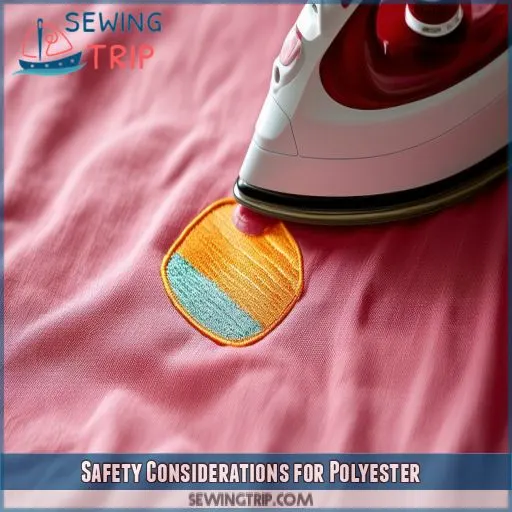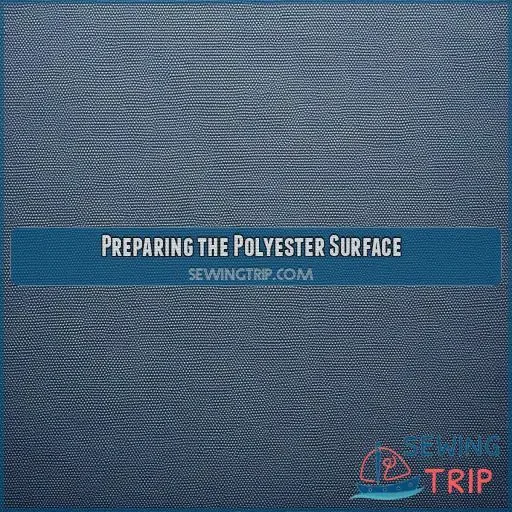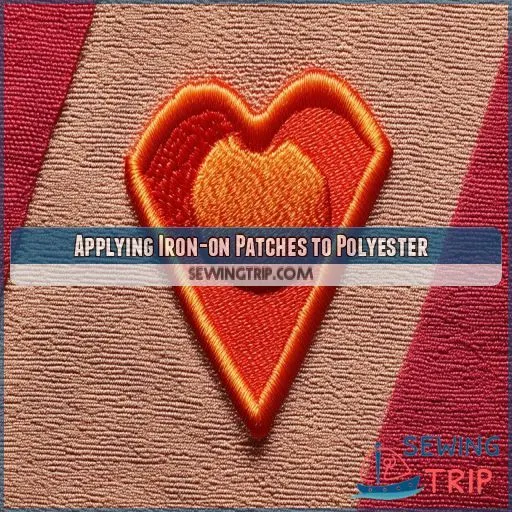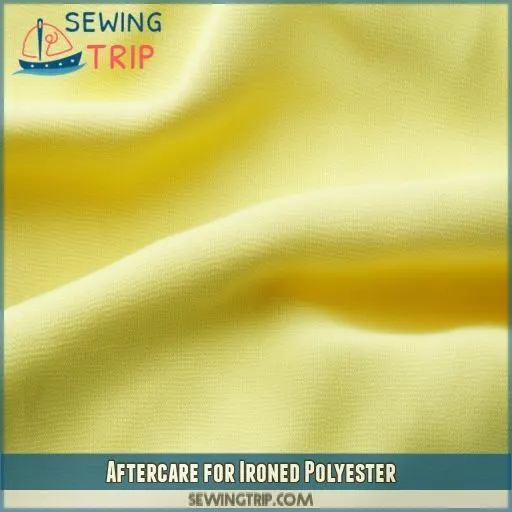This site is supported by our readers. We may earn a commission, at no cost to you, if you purchase through links.
 You may not know this, but 60% of all clothing repairs require patches. So, if you are asking, "Can you put iron-on patches on polyester?", rest assured you’re not alone. This 2024 guide describes safe methods of putting iron-on patches onto polyester without damaging your fabric.
You may not know this, but 60% of all clothing repairs require patches. So, if you are asking, "Can you put iron-on patches on polyester?", rest assured you’re not alone. This 2024 guide describes safe methods of putting iron-on patches onto polyester without damaging your fabric.
We will examine some essential safety considerations, the proper heat settings for application, and techniques for applying patches correctly. You will discover how to prepare your polyester surface for a patch, apply patches effectively onto it, and care for your newly patched garment.
Master this technique and you will be able to help your favorite polyester pieces live a little longer.
Table Of Contents
Key Takeaways
- You bet your bottom dollar you can slap iron-on patches on polyester! Just remember, this fabric’s as sensitive as a teenager’s feelings, so handle with care and keep that iron temperature lower than a limbo stick at a beach party.
- Preparation is key, folks. Clean that polyester like you’re expecting the in-laws – no dirt, no wrinkles, no excuses. A little elbow grease now saves a patchy disaster later.
- When it comes to applying the patch, slow and steady wins the race. Use a lightweight cloth as a buffer, press firmly (but don’t go all Hulk on it), and resist the urge to slide that iron around like you’re waxing a car.
- Aftercare is where the magic happens. Treat your newly patched polyester like a delicate flower – cool water washes, inside-out laundering, and line drying. Your patch will stick around longer than that weird smell in your gym bag.
Can You Put Iron on Patches on Polyester?
Yes, you can iron onto polyester but it needs one to be a bit cautious. This is due to the fact that polyester is a heat-sensitive fabric and will melt if you are not careful enough.
Run a temperature of around 275°F to 300°F on your iron. Start always at the lowest temperature and slowly raise it according to your need. Clean the surface before placing the patch, and use a pressing cloth for extra protection.
Most importantly, test on a small hidden area first so that you don’t end up damaging the fabric. With the right technique, iron-on patches can actually work on your articles made of polyester.
Proper application and aftercare will give your newly patched item a longer life.
Safety Considerations for Polyester
One should, therefore, be aware that polyester is a heat-sensitive material and may melt under the iron. This will require proper temperature setting on your iron to avoid destroying the material while still effectively holding an iron-on patch.
Heat Sensitivity Risks
You’re walking on really thin ice when applying iron-on patches to polyester, as it can be a minefield of heat sensitivity. Your fabric hangs in the balance. There’s what you need to watch out for:
- Fabric damages: Excessive heat can melt or scorch polyester fibers.
- Patch distortion: High temperatures may bend your design
- Adhesive failure: Incorrect heat prevents proper bonding –
- Heat shrinkage: polyester can be a fiber that contracts, thus ruining your garment’s fit.
Knowing these risks is of high criticality to the successful application of patches and material safety.
Proper Temperature Settings
While ironing with polyester, the temperature should be apt and safe. One must work within the heat tolerance of the fabric in order not to burn or scorch it—that is, generally between 275°F and 300°F.
Refer to your iron’s manual for optimum settings on polyester at all times. Begin with a low temperature and raise slowly if necessary.
Again, exceeding these temperature limits could result in damage to the fabric itself. These precautions will ensure that the patches are attached safely but effectively without ruining your garment in the process.
Fabric Melting Concerns
On polyester, you’re walking a thin line with iron-on patches—excessive heat can melt the fabric, create adhesion problems, or irreparably mar your garment.
Be on the lookout for discoloration of the fabric and damaged fibers, which will significantly impact its looks and patch durability.
You should note that once polyester melts, limitations for repairing it come into play.
You want just the right balance so you don’t end up with something sticky.
Heat Settings for Ironing Polyester
Now, knowing the safety risks, let’s get into properly setting heat for ironing polyester. You want to preheat the iron to a lower or medium heat setting; this usually falls around 300°F. It’s that sweet spot which lets you iron out those wrinkles without putting your fabric into jeopardy. Remember, though, that polyester is very sensitive to high temperatures, so it’s always better to be on the safe side.
Most irons these days have a polyester or synthetic setting that really takes the guesswork out of temperature selection. In case your iron isn’t fitted with this, begin with the lowest heat and go higher if needed. As for steam settings, use them sparingly or not at all. Polyester usually doesn’t need additional moisture to take wrinkles out; more than that can cause excess steam and lead to water spots or other kinds of damage.
Preparing the Polyester Surface
Before you get on to applying the iron-on patch, proper fabric preparation should be the step that gets you started toward success. First, clean your polyester surface of dirt, oils, or residue that can inhibit good adhesion. Run a lint roller or soft brush across the polyester to remove any loose fibers. Then, make sure the garment is wrinkle-free. Although most polyesters are wrinkle-resistant, it never hurts to take a quick steam or a pass with a low-heat iron.
If you have an area that already has been patched, you need to remove the old adhesives from it without damaging the fabric. It’s imperative for a clean application. Before committing to the full patch, it’s a good idea to do a little test on a small, inconspicuous area first. This gives you a feel for the reaction of the polyester with regard to heat and ensures the patch adheres. With these steps done, you’re able to proceed with applying the actual patch.
Applying Iron-on Patches to Polyester
Now iron on your patch onto the prepped polyester surface. Carefully lay down the patch, considering the texture of the cloth and the design on it for maximum adhesive compatibility. Place a lightweight cloth over the patch to protect the polyester.
Iron until an acceptable temperature is reached, then press firmly for 15-20 seconds—never slide the iron, lift, and relocate. For bigger patches, do them in pieces. Let the fabric cool for about a minute after the initial press.
Check the edges. If they aren’t fused completely, press again. The more patient you are, the longer it will last. Some patches take extra time when pressing. If this is your specific case, then check.
It’s recommended to apply a pressing cloth if you have an intricate design or very thin polyester fabric for extra protection.
Aftercare for Ironed Polyester
Since you have successfully managed to iron on your patch with polyester, proper aftercare is essential to the survival of the patch and the fabric. Allow it to cool first before handling it. Always remain vigilant for discoloration of the fabric; this can be caused by an ironing temperature that was a bit too high. All isn’t lost if there are problems—many can be rectified by careful attention.
To remove a patch, use a hair dryer to loosen the adhesive, then peel off. If there’s some adhesive residue left, try using fabric-safe solvents. Laundry should be inside out in cool water to stop the patch from coming undone. Line drying is recommended rather than high heat because high heat may reactivate the adhesive and cause undesirable sticking. So by following these after-care tips, you’ll have your patched polyester item looking good for years to come.
Frequently Asked Questions (FAQs)
Can iron-on patches be removed from polyester?
Yes, you can remove iron-on patches from polyester. Use heat to soften the adhesive, then gently peel off the patch. For stubborn residue, try a commercial adhesive remover. Be cautious to avoid damaging the fabric.
How long do iron-on patches last on polyester?
Ever wondered about the lifespan of your favorite embellishments? Iron-on patches on polyester can last for years with proper care. You’ll enjoy long-lasting durability if you follow application instructions carefully and avoid frequent washing or harsh detergents.
Are there alternatives to ironing patches on polyester?
You’ve got options beyond ironing for polyester patches. Consider fabric glue, sewing, or velcro strips. These alternatives can be easier and safer for delicate fabrics. Choose the method that best suits your skill level and project needs.
Can you layer multiple iron-on patches on polyester?
You would think layering patches would be a piece of cake, right? Not exactly; it’s tricky. Yes, you can layer iron-on patches on to polyester, but you need to just press them one at a time, letting each cool completely.
Do iron-on patches work on stretchy polyester fabrics?
Iron-on patches can work on stretchy polyester, but you’ll need to take extra care. Use a pressing cloth and lower heat setting. Be cautious, as the patch may crack or peel when the fabric stretches.
Conclusion
Ironically, the question "Can you put iron-on patches on polyester?" has a simple answer: yes, you can.
By following the safety considerations, heat settings, and application techniques outlined in this guide, you’ll be able to repair your polyester garments with confidence.
Remember to prepare the surface, use the correct temperature, and apply patches carefully. With these skills, you’ll extend the life of your favorite polyester pieces and save money on replacements.
Don’t let a small tear or hole defeat you – patch it up and wear it proudly.











